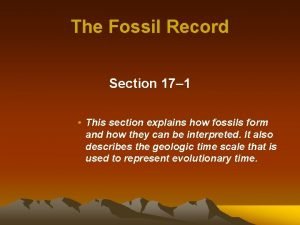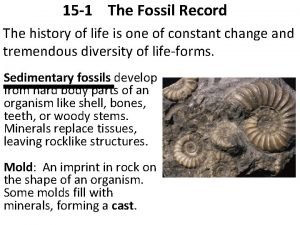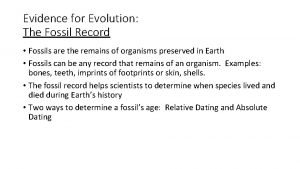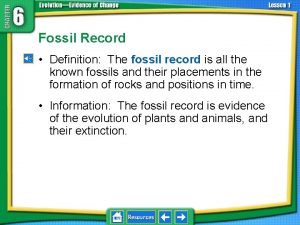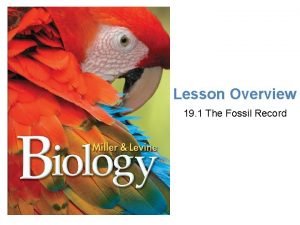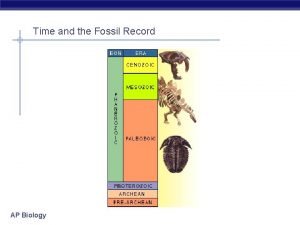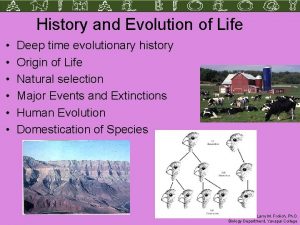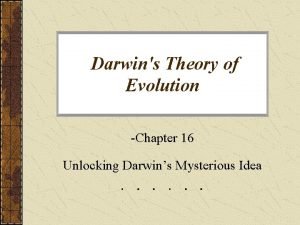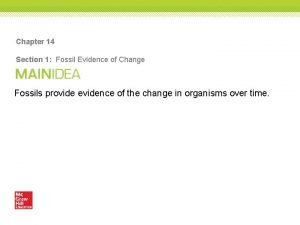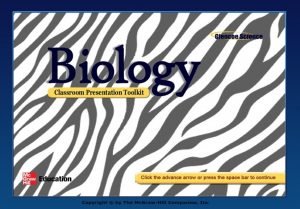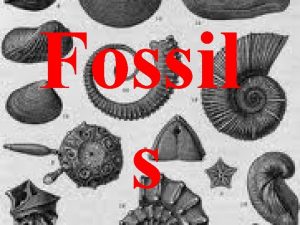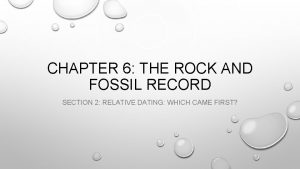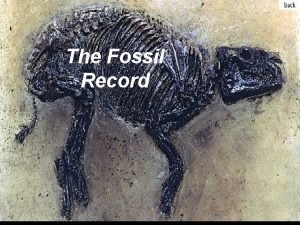The Rock Record Section 3 The Fossil Record














- Slides: 14

The Rock Record Section 3: The Fossil Record Preview • Key Ideas • Interpreting the Fossil Record • Fossilization • Types of Fossils • Index Fossils and Absolute Age • Maps in Action Section 3

The Rock Record Section 3 Key Ideas • Describe four ways in which entire organisms can be preserved as fossils. • List five examples of fossilized traces of organisms. • Describe how index fossils can be used to determine the age of rocks.

The Rock Record Section 3 Interpreting the Fossil Record • fossils the trace or remains of an organism that lived long ago, most commonly preserved in sedimentary rock. • paleontology the scientific study of fossils. • Fossils are an important source of information for finding the relative and absolute ages of rocks. • Fossils also provide clues to past geologic events, climates, and the evolution of living things over time.

The Rock Record Section 3 Interpreting the Fossil Record, continued • Almost all fossils are discovered in sedimentary rock. • The fossil record provides information about the geologic history of Earth. • Scientists can use this information to learn about how environmental changes have affected living organisms.

The Rock Record Section 3 Fossilization • Only dead organisms that are buried quickly or protected from decay can become fossils. • Generally only the hard parts of organisms, such as wood, bones, shells, and teeth, become fossils. • In rare cases, an entire organism may be preserved. • In some types of fossils, only a replica of the original organism remains. Others merely provide evidence that life once existed. Mummification • Mummified remains are often found in very dry places, because most bacteria which cause decay cannot survive in these places. • Some ancient civilizations mummified their dead by carefully extracting the body’s internal organs and then wrapping the body in carefully prepared strips of cloth.

The Rock Record Section 3 Fossilization, continued Amber • Hardened tree sap is called amber. Insects become trapped in the sticky sap and are preserved when the sap hardens. • In many cases, delicate features such as legs and antennae have been preserved. In rare cases, DNA has been recovered from amber. Tar Seeps • When thick petroleum oozes to Earth’s surface, the petroleum forms a tar seep, which are commonly covered by water. Animals that come to drink the water can become trapped in the sticky tar. • The remains of the trapped animals are covered by the tar and preserved.

The Rock Record Section 3 Fossilization, continued Freezing • The low temperatures of frozen soil and ice can protect and preserve organisms. • Because most bacteria cannot survive freezing temperatures, organisms that are buried in frozen soil or ice do not decay. Petrification • Mineral solutions such as groundwater replace the original organic materials that were covered by layers of sediment with new materials. • Some common petrifying minerals are silica, calcite, and pyrite. • The substitution of minerals for organic material other results in the formation of a nearly perfect mineral replica of the original organism.

The Rock Record Section 3 Types of Fossils • trace fossil a fossilized mark that formed in sedimentary rock by the movement of an animal on or within soft sediment. • In some cases, no part of the original organism survives in fossil form. But the fossilized evidence of past animal movement can still provide information about prehistoric life. • A trace fossils in an important clue to the animal’s appearance and activities.

The Rock Record Section 3 Reading Check What is a trace fossil? A trace fossil is a fossilized evidence of past animal movement, such as tracks, footprints, borings, or burrows, that can provide information about prehistoric life.

The Rock Record Section 3 Types of Fossils, continued Carbon films • Carbonized residues of leaves, stems, flowers, and fish made in soft mud or clay have been found preserved in sedimentary rock. • When original organic material partially decays, it leaves behind a carbon-rich film that displays the surface features of the organism. Molds and Casts • Shells often leave empty cavities called molds within hardened sediment. When a shell is buried, its remains eventually decay and leave an empty space. • When sand or mud fills a mold and hardens, a natural cast forms. A cast is a replica of the original organism.

The Rock Record Section 3 Types of Fossils, continued Coprolites • Fossilized dung or waste materials from ancient animals are called coprolites. • They can be cut into thin sections and observed through a microscope. The materials identified in these sections reveal the feeding habits of ancient animals, such as dinosaurs. Gastroliths • Some dinosaurs had stones in their digestive systems to help grind their food. In many cases, these stones, which are called gastroliths, survives as fossils. • Gastroliths can often be recognized by their smooth, polished surfaces and by their close proximity to dinosaurs remains.

The Rock Record Section 3 Index Fossils • index fossil a fossil that is used to establish the age of rock layers because it is distinct, abundant, and widespread and existed for only a short span of geologic time. • Paleontologists can use index fossils to determine the relative ages of the rock layers in which the fossils are located. • To be an index fossil, a fossil must be present in rocks scattered over a large region, and it must have features that clearly distinguish it from other fossils. • In addition, organisms from which the fossil formed must have lived during a short span of geologic time, and the fossil must occur in fairly large numbers within the rock layers.

The Rock Record Section 3 Index Fossils and Absolute Age • Scientists can use index fossils to estimate absolute ages of specific rock layers. • Because organisms that formed index fossils lived during short spans of geologic time, the rock layer in which an index fossil was discovered can be dated accurately. • Scientists can also use index fossils to date rock layers in separate area. • Index fossils are used to help locate rock layers that are likely to contain oil and natural gas deposits.

The Rock Record Maps in Action Geologic Map of Bedrock in Ohio Section 3
 17-1 the fossil record
17-1 the fossil record What is absolute age?
What is absolute age? Metamorphic rocks
Metamorphic rocks Examples of fossil evidence
Examples of fossil evidence Analogous structures defintion
Analogous structures defintion What is the “fossil record”?
What is the “fossil record”? Skeletal system
Skeletal system Fossil record
Fossil record Darwin viewed the fossil record as
Darwin viewed the fossil record as Chapter 14 section 1 fossil evidence of change study guide
Chapter 14 section 1 fossil evidence of change study guide Fossil fuel deposits
Fossil fuel deposits The history of life section 1 fossil evidence of change
The history of life section 1 fossil evidence of change Rock cycle
Rock cycle Igneous metamorphic sedimentary
Igneous metamorphic sedimentary Adventure sports bungee jumping
Adventure sports bungee jumping
